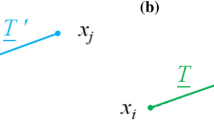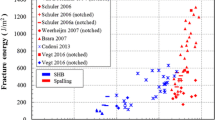Abstract
The paper reviews the influence of structural effects on the softening of concrete in multiaxial compression. The post-peak stress-deformation response of concrete subjected to uni- and multiaxial compression is influenced by geometrical and boundary condition effects. Comparison of results obtained by various investigators indicates that fracture in compression is a localized phenomenon. Conical intact material elements are separated by discrete shear bands. Structural effects determine the movement of the intact blocks with respect to one another. Material aspects of softening include the appearance of intact (grain) bridges in the shear bands, and frictional restraint in the shear band. The similarities with fracture in uniaxial tension are outlined. In the latter case crack interface grain bridging is observed too, which is considered as the salient characteristic of the fracture of brittle disordered materials.
Similar content being viewed by others
References
Gerstle, K. H.et al., ‘Strength of concrete under multiaxial stress-states’, in Douglas McHenry International Symposium on Concrete and Concrete Structures, ACI-SP55-5 (1978), pp. 103–131.
Van Mier, J. G. M., ‘Strain-softening of concrete under multiaxial loading conditions’, Dissertation, Eindhoven University of Technology, Eindhoven (1984).
Read, H. E. and Hegemier, G. A., ‘Strain-softening of rock, soil and concrete—a review article’,Mech. Mater. 3 (1984) 271–294.
Hudson, J. A., Brown, E. T. and Fairhurst, C., ‘Shape of the complete stress-strain curve for rock’ in ‘Stability of Rock Slopes’, Proceedings of 13th International Symposium on Rock Mechanics, University of Illinois, Urbana, 1971, edited by E. J. Cording, (ASCE, New York, 1972), pp. 773–795.
Vonk, R. A., Rutten, H. S., Van Mier, J. G. M. and Fijneman, H. J., ‘Influence of boundary conditions on softening of concrete loaded in compression’, in ‘Fracture of Concrete and Rock—Recent Developments’, edited by S. P. Shah, S. E. Swartz and B. Barr (Elsevier Applied Science, London, 1990), pp. 711–720.
Kotsovos, M. D., ‘Effect of testing techniques on the post-ultimate behaviour of concrete in compression’,Mater. Struct. 16(91) (1983) 3–12.
Bažant, Z. P., ‘Identification of strain-softening constitutive relation from uniaxial tests by series coupling model for localization’,Cement Concr. Res. 19(6) (1989) 973–977.
Shah, S. P. and Sankar, S., ‘Internal cracking and strain softening response of concrete under uniaxial compression’,ACI Mater. J. 84 (1987) 200–212.
Vonk, R. A., ‘Influence of boundary conditions on the softening of concrete in compression’, Research Report TUE/BKO-89.14 (Eindhoven University of Technology, 1989).
Paterson, M. S., ‘Experimental rock deformation—the brittle field’ (Springer, New York, 1978).
Van Mier, J. G. M., ‘Internal crack detection in single edge notched concrete plates subjected to uniform boundary displacement’, in ‘Micro-Mechanics of Failure of Quasi Brittle Materials’, edited by S. P. Shah, S. E. Swartz and M. Wang (Elsevier Applied Science, London, 1990), pp. 33–42.
Author information
Authors and Affiliations
Rights and permissions
About this article
Cite this article
Van Mier, J.G.M., Vonk, R.A. Fracture of concrete under multiaxial stress-recent developments. Materials and Structures 24, 61–65 (1991). https://doi.org/10.1007/BF02472683
Published:
Issue Date:
DOI: https://doi.org/10.1007/BF02472683




